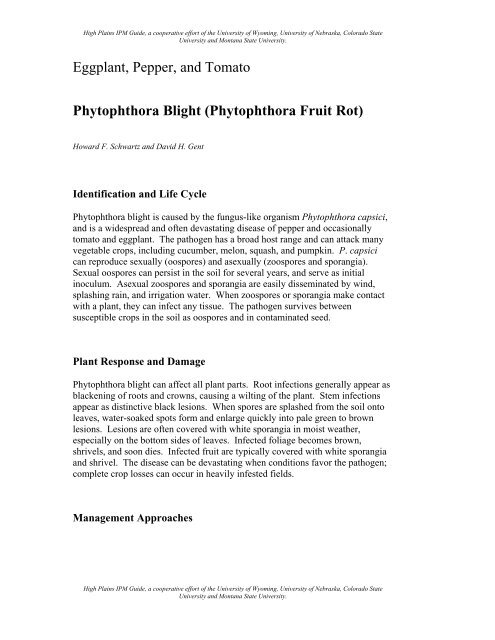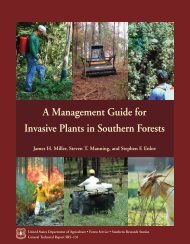Eggplant, Pepper, and Tomato XXIV - Phytophthora Blight ...
Eggplant, Pepper, and Tomato XXIV - Phytophthora Blight ...
Eggplant, Pepper, and Tomato XXIV - Phytophthora Blight ...
You also want an ePaper? Increase the reach of your titles
YUMPU automatically turns print PDFs into web optimized ePapers that Google loves.
High Plains IPM Guide, a cooperative effort of the University of Wyoming, University of Nebraska, Colorado State<br />
University <strong>and</strong> Montana State University.<br />
<strong>Eggplant</strong>, <strong>Pepper</strong>, <strong>and</strong> <strong>Tomato</strong><br />
<strong>Phytophthora</strong> <strong>Blight</strong> (<strong>Phytophthora</strong> Fruit Rot)<br />
Howard F. Schwartz <strong>and</strong> David H. Gent<br />
Identification <strong>and</strong> Life Cycle<br />
<strong>Phytophthora</strong> blight is caused by the fungus-like organism <strong>Phytophthora</strong> capsici,<br />
<strong>and</strong> is a widespread <strong>and</strong> often devastating disease of pepper <strong>and</strong> occasionally<br />
tomato <strong>and</strong> eggplant. The pathogen has a broad host range <strong>and</strong> can attack many<br />
vegetable crops, including cucumber, melon, squash, <strong>and</strong> pumpkin. P. capsici<br />
can reproduce sexually (oospores) <strong>and</strong> asexually (zoospores <strong>and</strong> sporangia).<br />
Sexual oospores can persist in the soil for several years, <strong>and</strong> serve as initial<br />
inoculum. Asexual zoospores <strong>and</strong> sporangia are easily disseminated by wind,<br />
splashing rain, <strong>and</strong> irrigation water. When zoospores or sporangia make contact<br />
with a plant, they can infect any tissue. The pathogen survives between<br />
susceptible crops in the soil as oospores <strong>and</strong> in contaminated seed.<br />
Plant Response <strong>and</strong> Damage<br />
<strong>Phytophthora</strong> blight can affect all plant parts. Root infections generally appear as<br />
blackening of roots <strong>and</strong> crowns, causing a wilting of the plant. Stem infections<br />
appear as distinctive black lesions. When spores are splashed from the soil onto<br />
leaves, water-soaked spots form <strong>and</strong> enlarge quickly into pale green to brown<br />
lesions. Lesions are often covered with white sporangia in moist weather,<br />
especially on the bottom sides of leaves. Infected foliage becomes brown,<br />
shrivels, <strong>and</strong> soon dies. Infected fruit are typically covered with white sporangia<br />
<strong>and</strong> shrivel. The disease can be devastating when conditions favor the pathogen;<br />
complete crop losses can occur in heavily infested fields.<br />
Management Approaches<br />
High Plains IPM Guide, a cooperative effort of the University of Wyoming, University of Nebraska, Colorado State<br />
University <strong>and</strong> Montana State University.
High Plains IPM Guide, a cooperative effort of the University of Wyoming, University of Nebraska, Colorado State<br />
University <strong>and</strong> Montana State University.<br />
Biological Control<br />
Soil solarization <strong>and</strong> incorporation of organic amendments can reduce soil<br />
inoculum levels <strong>and</strong> subsequent disease development.<br />
Cultural Control<br />
Plant high quality seed free from P. capsici. Plant into well-prepared raised beds<br />
<strong>and</strong> evenly leveled fields that promote rapid drainage of irrigation <strong>and</strong> rain water.<br />
Use drip rather than sprinkler or furrow irrigation if possible. Prevent excessive<br />
moisture. Avoid planting into fields with known salinity problems. Straw<br />
mulches reduce splash dispersal of soilborne inoculum <strong>and</strong> can reduce foliar<br />
infection. Practice a three-year or longer crop rotation between susceptible crops.<br />
Plant resistant or tolerant varieties if available.<br />
Chemical Control<br />
P. capsici resistance to metalaxyl <strong>and</strong> mefenoxam is widespread in some regions,<br />
<strong>and</strong> alternative fungicides <strong>and</strong> disease management strategies should be used if<br />
resistant strains are present.<br />
Product List for <strong>Phytophthora</strong> <strong>Blight</strong>:<br />
Pesticide<br />
Product per<br />
acre<br />
Application<br />
Frequency (days)<br />
Remarks<br />
Famoxadone/Cymoxanil<br />
Tanos 8 oz 5-7 days Rotate <strong>and</strong> rotato<br />
with fungicides with<br />
a different mode of<br />
action such as<br />
chlorothalonil or<br />
mancozeb;<br />
Maximum of 72<br />
ounces per season; 3<br />
day PHI<br />
Mefenoxam<br />
Ridomil Gold EC 1-2 pts Broadcast or b<strong>and</strong>ed<br />
at planting;<br />
High Plains IPM Guide, a cooperative effort of the University of Wyoming, University of Nebraska, Colorado State<br />
University <strong>and</strong> Montana State University.
High Plains IPM Guide, a cooperative effort of the University of Wyoming, University of Nebraska, Colorado State<br />
University <strong>and</strong> Montana State University.<br />
Maximum of three<br />
injections by drip<br />
irrigation; maximum<br />
of three pts per<br />
season; 7 day PHI<br />
Ridomil Gold GR 20 lbs B<strong>and</strong> (7”) or<br />
broadcast <strong>and</strong><br />
incorporate with 0.5<br />
to 1” of irrigation<br />
water; a second<br />
application can be<br />
made; 7 day PHI<br />
Maximum of 40<br />
pounds per season;<br />
7 day PHI<br />
Ridomil Gold/Bravo 1.5-2.0 lb 7-14 days Make 3 total sprays;<br />
14 day PHI<br />
Ridomil Gold/Copper 1 pack/per 2.5<br />
acres<br />
5-14 days Make 3 total sprays;<br />
14 day PHI<br />
The information herein is supplied with the underst<strong>and</strong>ing that no discrimination is intended <strong>and</strong> that listing of commercial products, necessary to<br />
this guide, implies no endorsement by the authors or the Extension Services of Nebraska, Colorado, Wyoming or Montana. Criticism of products or<br />
equipment not listed is neither implied nor intended. Due to constantly changing labels, laws <strong>and</strong> regulations, the Extension Services can assume<br />
no liability for the suggested use of chemicals contained herein. Pesticides must be applied legally complying with all label directions <strong>and</strong><br />
precautions on the pesticide container <strong>and</strong> any supplemental labeling <strong>and</strong> rules of state <strong>and</strong> federal pesticide regulatory agencies. State rules <strong>and</strong><br />
regulations <strong>and</strong> special pesticide use allowances may vary from state to state: contact your State Department of Agriculture for the rules,<br />
regulations <strong>and</strong> allowances applicable in your state <strong>and</strong> locality.<br />
Categories: <strong>Eggplant</strong>, <strong>Pepper</strong>, <strong>Tomato</strong>, Disease, <strong>Phytophthora</strong> <strong>Blight</strong>,<br />
<strong>Phytophthora</strong> Fruit Rot<br />
Date: 04/01/2007<br />
High Plains IPM Guide, a cooperative effort of the University of Wyoming, University of Nebraska, Colorado State<br />
University <strong>and</strong> Montana State University.

















